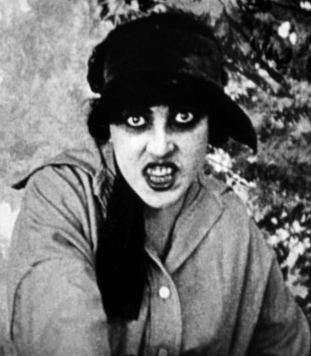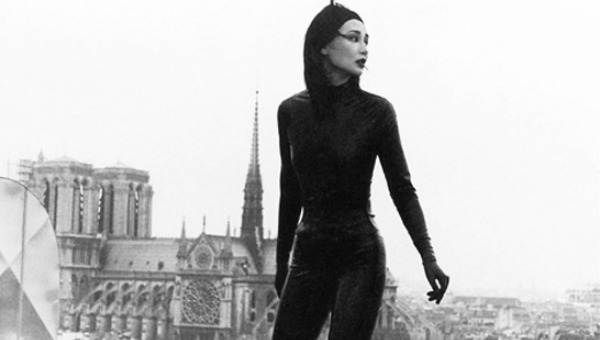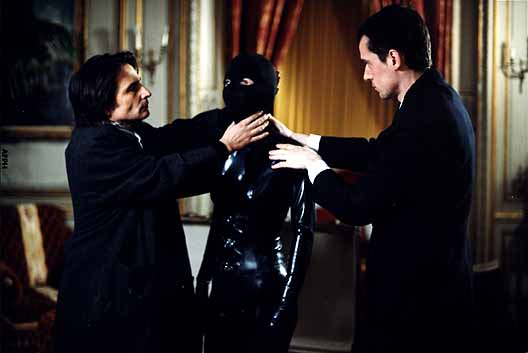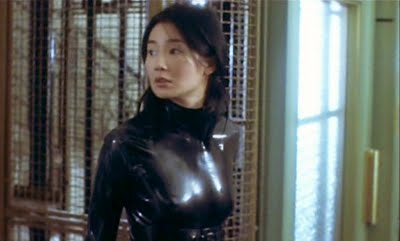Director and screenwriter Olivier Assayas’ IRMA VEP follows the experiences of a group of filmmakers whose professional and personal lives are touched by Chinese movie star Maggie Cheung, playing herself. Maggie is cast as “Irma Vep”, the lead role in a remake of LES VAMPIRES, a 1915 silent film serial that heavily influenced the dark burlesque of Edward Gorey. The director within the film is René, a huffing, puffing Truffaut, a burnt-out genius who’s trying to re-ignite his own passion. He needs rehab and subtitles, which are only provided when he speaks French. When watching any subtitled film, even a basic knowledge of the original language will intimate countless nuances that are being ignored or misrepresented in translation. Here, this flaw in mediation betwixt writer and audience is echoed in the fundamental theme of frustrated communication, the pidgin of different tongues mixing and colliding in the language of love.
It’s not all about the pretty polyglot, the swipe at Old Wave cinema…
However, one occurrence of regrettable metaphrasing in the closed captions stands out. The bonus features include an interview with Assayas during which the subtitles transcribe his words thus: “Irma Vep is really about one thing only – being in the presence of brilliance. It’s a comedy about brilliance”. Characters in the film might idolise the heroine, Maggie, and mourn the lost genius of director René, but this film is not about their brilliance. It’s not all about the pretty polyglot, the swipe at Old Wave cinema. Assayas tends to choose his words very carefully, and in this instance he is actually saying “grace”. The concept of grace has been very important to him since he explored it with the wonderful Italian surrealist painter Francesco Clemente. While publicising Assayas’ later film LATE AUGUST, EARLY SEPTEMBER, he described “grace” as a liberation from the weight of the world, of technique, of convention and of money. He truly believes that filmmaking can and should be graceful and organic, almost a case of art creating itself using man as a facilitator. IRMA VEP is about the grace that René and Assayas wish to capture – an innocence, a purity and fecundity, more oie blanche than chatte noire.
Vamp (n.) something pieced together, repaired or patched up
Working happily and rapidly on a low budget, Assayas follows Godard’s path, winding through a number of character-based vignettes but not straying so close as to allow any one story to overwhelm his deconstructed narrative. The camera tacks unblinkingly through group interaction scenes, tangling around the performers. The grace of LES VAMPIRES, René declares, lay in its unabashed individuality and novelty. Feuillade shunned the conventions represented by his contemporary D. W. Griffith’s THE BIRTH OF A NATION. And it is this originality to which Assayas aspires. The Lettrist coda to this film could have been created by Man Ray in collaboration with Kyle Cooper, the title sequence designer for films such as SE7EN, whose stylstic influences were so widely plagiarised in the mid-nineties. Man Ray once said, “It has never been my object to record my dreams, just the determination to realise them.” René’s desperate edit of IRMA VEP is an ode to Maggie, a cri de coeur. René has been sucked dry, and this is the tragic expression of his own falling from grace. His impotent, inarticulate vandalism of the film stock, his frenzied, abrasive tracing of Maggie’s flickering image surfing on tearing tape hisses fade to palsied pellicule and a drowning rumble.
Vamp (n.) “Seductive woman,” 1911, short for vampire
In LES VAMPIRES Musidora, the first grrl of the silver screen, was an icon of post-war feminine sexuality. Although she has sunk into obscurity, her influence has endured for decades. She may even have inspired Assayas’ own father, Jacques Remy, a prolific writer/director of pulp fiction who in 1958 brought us La Chatte: a Nazi-fighting proto-Catwoman. In 1977 “The New Adventures of Wonder Woman” saw Lynda Carter in a new Lycra wetsuit, also fighting Nazis, and displaying the same magnificent muttony hips as Musidora’s. When hips became un-hip, morally ambiguous icons of pop culture such as Peter Cheung’s animated double agent Aeon Flux, Frank Miller’s inky assassin Miho of “Sin City” and Luc Besson’s tiny Nikita went skinny but still held the torch. Live action performers who sold their kohl to Musidora range from Siouxsie Sioux via Polly Harvey to her most recent incarnation who can be identified as piano-vamping punk cabaret queen Amanda Palmer of the Dresden Dolls.
Her outfit forms a black canvas, and those whom she touches can project their fears and desires onto her unguardedly.
Had Assayas been seeking a true heir to the mantle of Musidora, he might have approached Michelle Yeoh, who co-starred with Cheung in Johnny To’s HEROIC TRIO as well as HOLY WEAPON, in which the breadth of Yeoh’s sex appeal is explored through cross-dressing. Yeoh might not have such a pretty nose, but she performs all her own stunts. However, Assayas was completely aware of his own reasons for casting Cheung. He saw in her a warm, gamine confidante whose felinity lies not in acrobatic bloodlust but in her universal charm and disarmament. Her outfit forms a black canvas, and those whom she touches can project their fears and desires onto her unguardedly. Arletty of LES ENFANTS DU PARADIS put this concept of universal appeal succinctly from a French perspective: “My heart is French but my ass is international”.
Wuxia meets anorexia when Cheung is spurred from her lassitude by Sonic Youth’s “Tunic”, a song written for body dysmorphic Karen Carpenter. The solipsistic lyrics explore the feeling of being the sum of perceived parts, of being a tree falling in a forest with nobody around. There commences a sequence reminiscent of Peter Cheung’s elliptical Manhwa espionage, following the protagonist from hiding place to hiding place and framing the supporting characters as Hopper-esque snippets, as isolated from their voyeur as an actor is from a cinema audience. She spies on half a lover’s tiff, conducted over the phone by a substantial nude who resembles Musidora as painted by Munch, her red toenails, milky definition and sultry conviction more Musidora in that moment than Maggie’s tiptoe shadow. “Am I inventing this relationship on my own?” the nameless woman asks her unseen lover, as Maggie grabs a necklace and scampers onto the inevitable night-time roof, filtered “nuit americane” blue for the camera as it might have been eighty years earlier. Neat, powerful sights and sounds – the ripe squeak of latex, a handful of wet jewels falling through raindrops, punctuate the sequence.
“There is no progress in art, any more than there is progress in making love. There are simply different ways of doing it.”
The lack of emotional investment in most of the characters often leaves us feeling like eavesdroppers, which can become tiresome, but this sequence marks Maggie’s turning point from subject to object – she feels she has grown to understand René and feels loyalty towards him. When she misguidedly tried to lift René’s spirits by describing her role as “a game”, her attitude angered him and she grew to understand what an important role she had to play in his spiritual rekindling, and to feel that she must honour his dream and conspire to fulfil the promise of “grace” which she represents. “Why do it again?” René’s technicians wonder. They warn him that the remake is a “trap”. They might just as well ask and warn Zoé, who comes across as the type to fall in love every time a Chinawoman sneezes, and has been reading between Maggie’s stilted lines, spinning straw into gold – as lovers do. Man Ray provided a compelling explanation for man’s need to make the same mistakes repeatedly: “There is no progress in art, any more than there is progress in making love. There are simply different ways of doing it.”

Vamp (v.) to extemporise
The recreation of LES VAMPIRES offers the perfect opportunity for Assayas to take inspiration from one of his cited influences, David Mamet, whose pragmatic, naturalistic approach blends well with the New Wave cinéma vérité paradigm. However, Mamet stresses in his “True and False” acting primer that that the study of acting consists in challenging oneself and “being comfortable being uncomfortable”. It would appear that Maggie was wrapped in cotton wool as much as latex, and allowed to roam free. Cheung’s inexperience in “being oneself” on camera flattens her performance dreadfully. Mamet would have warned Assayas that naturalism is not as simple as ignoring the camera – it must be contrived. Cheung evokes, oblivion, candour and fascination – but it’s very hard to relate to her. Her inscrutability seems deliberate at times. She is not afraid of being given free rein – she is a superstar and has nothing to prove – and yet she often appears to be at a loss, apologetic in her performance, as though she feels she is being given an easy ride compared to the other performers whose colour she only serves to reflect. This pattern of accompaniment is reflected in two key musical numbers in the film. The dispassionate, sometimes disdainful female vocals from Sonic Youth’s Kim Gordon and Luna’s Britta Phillips are given body by powerful musical accompaniment. If Maggie is the melody then Zoé and the other characters form the rich rhythm that bears and transforms her from one moment to the next.
Vamp (v.) to use feminine charms upon; to seduce
During their first rendezvous, Chinese Maggie eats noodles and French Zoé munches cheese. Can opposites attract? The character of Zoé is often dismissed in reviews as “the lesbian wardrobe mistress who falls in love with Maggie” – reducing her to a figure who only serves to illustrate the cross-gender appeal of the heroine. This treatment does a disservice to both character and performer. Zoé is not a lesbian – her friend Maïté explains to Maggie that Zoé loves “girls, boys and latex” in equal measure. And it is Zoé who is the vamp of the film, albeit a Gallic Jane Horrocks of a vamp. As Zoé, Nathalie Richard is the seducer, the meatiest character of the piece, and she mentioned in the featured interview that she was delighted at being given a comedic role. Her frailty and charm evoke the most sympathy of all the characters. Maggie is almost the kittenish Mary Pickford to her Theda Bara.
You don’t need to be fluent in Bambara to respond to the warmth and honesty of Maggie and Zoé’s love theme, Ali Farka Touré’s Mali love song “Soukora”. The second time it is used, the earthy swing of the love spell is cruelly curtailed, yielding to the feverish techno hardbeat of the club where Zoé is abandoned by Maggie to wallow in her delirium. Soukora was used to winsome effect a year later in Griffin Dunne’s sweet romantic comedy ADDICTED TO LOVE, which also featured a cat-suited “Maggie” character and dealt with themes of doomed, clumsy love, and the potency of a fish out of water whose attraction lies chiefly in its divorce from context. And so Zoé’s hopes are in this scene dashed to the ground, along with the contents of her handbag as she searches for an ecstasy tablet – that cheap shortcut to wholeheartedness and contentment.
The extras begin with an innocent yet fetishistic Lettrist portrait of Maggie Cheung, which leaves one feeling like a peeping tom. Then we meet Oliver Assayas, and his display of nervous energy and articulate enthusiasm complete his resemblance to Quentin Tarantino, which was hitherto mostly stylistic – the championing of obscure Eastern film, the drawing of multiple influences, the way with steadicam and dialogue, the glamourising of women who kick ass. Assayas is desperate to edify film lovers whose appreciation of Chinese cinema is stunted by heavy exposure to John Woo films and the beat-‘em-up video games of Namco and Capcom. On first impression, his film might be dismissed prematurely by someone who does not fancy Maggie Cheung, or who is not au fait with the melodrama of 90s French filmmaking. However, Assayas stresses that in this film, and in life, you either do or do not see the “grace”. “Grace has come and gone. Who saw it and who didn’t?” And if you do not see the grace in this film, then tant pis.
IRMA VEP screens at Bradford Film Festival on Wednesday 25 April at 8pm. Olivier Assayas (one of this year’s special guests, alongside Barbara Windsor) will introduce the film.
This article originally appeared in Vertigo Magazine, Issue 16, March 2008




2 thoughts on “BIFF2012: Irma Vep”
Comments are closed.